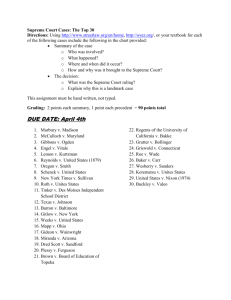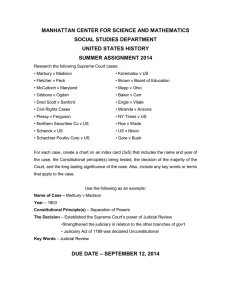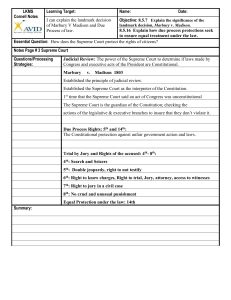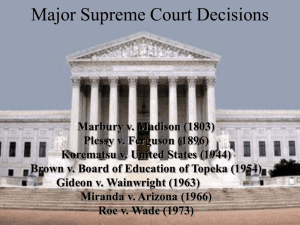Landmark Decisions - NortheasternSeniorHighCivics
advertisement
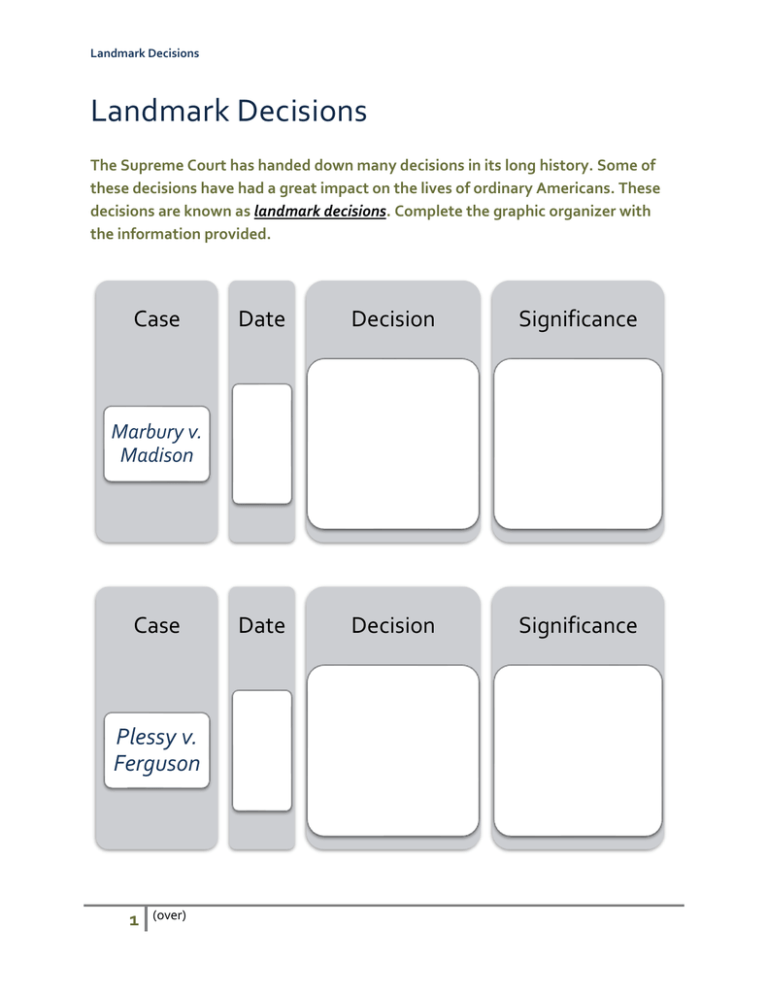
Landmark Decisions Landmark Decisions The Supreme Court has handed down many decisions in its long history. Some of these decisions have had a great impact on the lives of ordinary Americans. These decisions are known as landmark decisions. Complete the graphic organizer with the information provided. Case Date Decision Significance Date Decision Significance Marbury v. Madison Case Plessy v. Ferguson 1 (over) Landmark Decisions Case Date Decision Significance Date Decision Significance Brown v. Board of Education of Topeka Case Miranda v. Arizona 2 (over) Landmark Decisions Marbury v. Madison (1803) Background: William Marbury and others were appointed as judges by Federalist president John Adams during his last days in office. This act angered the new Democratic-Republican president, Thomas Jefferson. Jefferson ordered his secretary of state, James Madison, not to deliver the commissions. Marbury took advantage of a section in the Judiciary Act of 1789 that allowed him to take his case directly to the Supreme Court. He sued Madison, demanding the commission and the judgeship. Decision: This case was decided on February 24, 1803, by a vote of 5 to 0. Chief Justice John Marshall spoke for the Court, which decided against Marbury. The court ruled that although Marbury’s commission had been unfairly withheld, he could not lawfully take his case to the Supreme Court without first trying it in a lower court. Marshall said that the section of the Judiciary Act that Marbury had used was actually unconstitutional, and that the Constitution must take priority over laws passed by Congress. Significance: This ruling established the Supreme Court’s power of judicial review, by which the Court decides whether laws passed by Congress are constitutional. This decision greatly increased the prestige of the Court and gave the judiciary branch a powerful check against the legislative and executive branches. Plessy v. Ferguson (1896) Background: An 1890 Louisiana law required that all railway companies in the state use “separate butequal” railcars for white and African American passengers. A group of citizens in New Orleans banded together to challenge the law and chose Homer Plessy to test the law in 1892. Plessy took a seat in a whites-only coach, and when he refused to move, he was arrested. Plessy eventually sought review by the U.S. Supreme Court, claiming that the Louisiana law violated his Fourteenth Amendment right to equal protection. Decision: This case was decided on May 18, 1896, by a vote of 7 to 1. Justice Henry Billings Brown spoke for the Court, which upheld the constitutionality of the Louisiana law that segregated railcars. Justice John M. Harlan dissented [disagreed], arguing that the Constitution should not be interpreted in ways that recognize class or racial distinctions. Significance: This case upheld the constitutionality of racial segregation by ruling that separate facilities for different races were legal as long as those facilities were equal to one another. This case provided a legal justification for racial segregation for nearly 60 years until it was overturned by Brown v. Board of Education in 1954. 3 (over) Landmark Decisions Brown v. Board of Education (1954) Background: Beginning in the 1930s, the National Association for the Advancement of Colored People (NAACP) began using the courts to challenge racial segregation in public education. In 1952 the NAACP took a number of school segregation cases to the Supreme Court. These included the Brown family’s suit against the school board of Topeka, Kansas, over its “separate-but-equal” policy. Decision: This case was decided on May 17, 1954, by a vote of 9 to 0. Chief Justice Earl Warren spoke for the unanimous Court, which ruled that segregation in public education created inequality. The Court held that racial segregation in public schools was by nature unequal, even if the school facilities were equal. The Court noted that such segregation created feelings of inferiority that could not be undone. Therefore, enforced separation of the races in public education is unconstitutional. Significance: This ruling reversed the Supreme Court’s earlier position on segregation set by Plessy v. Ferguson (1896). The decision also inspired Congress and the federal courts to help carry out further civil rights reforms for African Americans. Miranda v. Arizona (1966) Background: In 1963 Ernesto Miranda was arrested in Arizona for a kidnapping. Miranda signed a confession and was later found guilty of the crime. The arresting police officers, however, admitted that they had not told Miranda of his right to talk with an attorney before his confession. Miranda appealed his conviction on the grounds that by not informing him of his legal rights the police had violated his Fifth Amendment right against self-incrimination. Decision: This case was decided on June 13, 1966, by a vote of 5 to 4. Chief Justice Earl Warren spoke for the Court, which ruled in Miranda’s favor. The Court decided that an accused person must be given four warnings after being taken into police custody: (1) the suspect has the right to remain silent, (2) anything the suspect says can and will be used against him or her, (3) the suspect has the right to consult with an attorney and to have an attorney present during questioning, and (4) if the suspect cannot afford a lawyer, one will be provided before questioning begins. Significance: This decision ruled that an accused person’s Fifth Amendment rights begin at the time of arrest. The ruling caused controversy because it made the questioning of suspects and collecting evidence more difficult for law enforcement officers. 4 (over)
